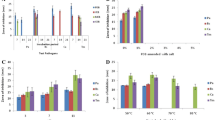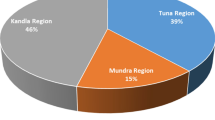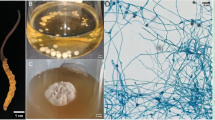Abstract
Hortaea werneckii is a black yeast-like ascomycetous fungi associated with the human superficial infection tinea nigra, which commonly occurs in tropical and subtropical countries. Now, this fungus has been found in the halophilic environment all over the world and recognized as a new model organism in exploring the mechanisms of salt tolerance in eukaryotes. During a survey of endophytic fungi of mangrove forest at South China Sea, two isolates of H. werneckii were recovered from medicinal plant of Aegiceras comiculatum. The isolates were identified by morphological characters and phylogenetic analyses (e.g., ITS rDNA, LSU rDNA and translation elongation factor EF1α). Some physiological tests such as thermotolerance, acid tolerance (pH) and NaCl tolerance as well as pathogenicity test in vitro for the strains of Hortaea were performed. It is the first report that H. werneckii was isolated from medicinal plant of A. comiculatum in south sea of China as the endophytic fungi.





Similar content being viewed by others
References
Hölker U, Bend J, Pracht R, Tetsch L, Müller T, Höfer M, de Hoog GS. Hortaea acidophila, a new acid-tolerant black yeast from lignite. Antonie Van Leeuwenhoek. 2004;86(4):287–94.
Crous PW, Schoch CL, Hyde KD, Wood AR, Gueidan C, de Hoog GS, Groenewald JZ. Phylogenetic lineages in the Capnodiales. Stud Mycol. 2009;64:17–47.
Crous PW, Braun U, Groenewald JZ. Mycospharella is polyphyletic. Stud Mycol. 2007;58:1–32.
Perez C, Colella MT, Olaizola C, de Capriles CH, Magaldi S, Mata-Essayag S. Tinea nigra: report of twelve cases in Venezuela. Mycopathologia. 2005;160:235–8.
Bonifaz A, Badali H, de Hoog GS, Cruz M, Araiza J, Cruz MA, Fierro L, Ponce RM. Tinea nigra by Hortaea werneckii, a report of 22 cases from Mexico. Stud Mycol. 2008;61:77–82.
Ng KP, Soo-Hoo TS, Na SL, Tay ST, Hamimah H, Lim PC, Chong PP, Seow HF, Chavez AJ, Messer SA. The mycological and molecular study of Hortaea werneckii isolated from blood and splenic abscess. Mycopathologia. 2005;159:495–500.
Gunde-Cimerman N, Ramos J, Plemenitas A. Halotolerant and halophilic fungi. Mycol Res. 2009;113:1231–41.
Turk M, Abramovic Z, Plemenitaš A, Gunde-Cimerman N. Salt stress and plasma-membrane fluidity in selected extremophilic yeasts and yeast-like fungi. FEMS Yeast Res. 2007;7:550–7.
Turk M, Plemenitaš A, Gunde-Cimerman N. Extremophilic yeasts: plasma-membrane fluidity as determinant of stress tolerance. Fungal Biol. 2011;115:950–8.
Petrovič U, Gunde-Clmerman N, Plemenitaš A. Cellular responses to environmental salinity in the halophilic black yeast Hortaea werneckii. Mol Microbiol. 2002;45:665–72.
Turk M, Plemenitaš A. The HOG pathway in the halophilic black yeast Hortaea werneckii: isolation of the HOG1 homolog gene and activation of HwHog1p. FEMS Microbiol Lett. 2002;216:193–9.
Lenassi M, Zajc J, Gostinčar C, Gorjan A, Gunde-Cimerman N, Plemenitaš A. Adaptation of the glycerol-3-phosphate dehydrogenase Gpd1 to high salinities in the extremely halotolerant Hortaea werneckii and halophilic Wallemia ichthyophaga. Fungal Biol. 2011;115:959–70.
Matis M, Zakelj-Mavric M, Peter-Katalinić J. Global analysis of the Hortaea werneckii proteome: studying steroid response in yeast. J Proteome Res. 2005;4(6):2043–51.
Gopal B, Chauhan M. Biodiversity and its conservation in the Sundarban mangrove ecosystem. Aquat Sci. 2006;68:338–54.
Kathiresan K, Bingham BL. Biology of mangroves and mangrove ecosystem. Adv Mar Biol. 2001;40:81–251.
Lin P. A review on the mangrove research in China. J Xiamen Univ Nat Sci. 2001;40:592–603.
Lin ZJ, Zhu TJ, Fang YC, Gu QQ, Zhu WW. Polyketides from Penicillium sp. JP-1, an endophytic fungus associated with the mangrove plant Aegicera corniculatum. Phytochemistry. 2008;69:1273–8.
Lin W, Li L, Fu H, Sattler I, Huang X, Grabley S. New cyclopentenone derivatives from an endophytic Streptomyces sp. isolated from the mangrove plant Aegiceras comiculatum. J Antibiot. 2005;58:594–8.
Xing XK, Guo SX. Fungal endophyte communities in four Rhizophoraceae mangrove species on the south coast of China. Ecol Res. 2011;26:403–9.
Höller U, Konig GM, Wright AD. Three new metabolites from marine-derived fungi of the genera Coniothyrium and Microsphaeropsis. J Nat Prod. 1999;62:114–8.
White TJ, Bruns T, Lee S, Taylor J. Amplification and direct sequencing of fungal ribosomal RNA genes for phylogenetics. In: Innis MA, Gelfand DH, Sninsky JJ, White TJ, editors. RCR protocols: a guide to methods and applications. New York: Academic Press; 1990. p. 315–22.
Chen J, Wang H, Guo SX. Isolation and identification of endophytic and mycorrhizal fungi from seed and root of Dendrobium (Orchidaceae). Mycorrhiza. 2012;22:297–307.
Tamura K, Peterson D, Peterson N, Stecher G, Nei M, Kumar S. MEGA5: molecular evolutionary genetics analysis using maximum likelihood, evolutionary distance, and maximum parsimony methods. Mol Biol Evol. 2011;28:2731–9.
Vettraino AM, Natili G, Anselmi N, Vannini A. Recovery and pathogenicity of Phytophthora species associated with a resurgence of ink disease in Castanea sativa in Italy. Plant Pathol. 2001;50:90–6.
Hughes JR, Moore MK, Pembroke AC. Tinea nigra palmaris. Clinical Exp Dermatol. 1993;18:481–3.
Ng KP, Soo-Hoo TS, Na SL, Tay ST, Hamimah H, Lim PC, Chong PP, Seow HF. Tinea nigra palmaris: a clinical case in Argentina. Rev Argent Microbiol. 2007;39:218–20.
Chavez AJ, Messer SA. The mycological and molecular study of Hortaea werneckii isolated from blood and splenic abscess. Mycopathologia. 2005;159:495–500.
Zalar P, de Hoog GS, Gunde-Cimerman N. Ecology of halotolerant dothideaceous black yeasts. Stud Mycol. 1999;43:38–48.
Waller F, Achatz B, Baltruschat H, Fodor J, Becker K, Fischer M, Heier T, Hückelhoven R, Neumann C, von Wettstein D, Franken P, Kogel KH. The endophytic fungus Piriformospora indica reprograms barley to salt-stress tolerance, disease resistance, and higher yield. PNAS. 2005;102:13386–91.
Schoch CL, Crous PW, Groenewald JZ et al. A class-wide phylogenetic assessment of Dothideomycetes. Stud Mycol 2009;64:1–15S10
Sharmin S, Haritani K, Tanaka R et al. The first isolation of Hortaea werneckii from a household guinea pig. Nippon Ishinkin Gakkai Zasshi, 2002;43(3):175–80.
Burgaud G, Arzur D, Durand L, Cambon-Bonavita MA,BarbierG. Marine culturable yeasts in deep-sea hydrothermal vents: species richness and association with fauna. FEMS Microbiol Ecol 2010;73(1):121–33.
De Leo F, Urzi C, de Hoog GS.A new meristematic fungus, Pseudotaeniolina globosa. Antonie Van Leeuwenhoek 2003;83(4):351–60.
Abliz P, Fukushima K, Takizawa K, Miyaji M, Nishimura K. Specific oligonucleotide primers for identification of Hortaea werneckii, a causative agent of tinea nigra. Diagn Microbiol Infect Dis 2003;46(2):89–93.
Rakeman JL, Bui U, Lafe K, Chen YC, Honeycutt RJ, Cookson BT. Multilocus DNA sequence comparisons rapidly identify pathogenic molds. J Clin Microbiol 2005;43(7):3324–33.
Cantrell SA, Casillas-Martinez L, Molina M. Characterization of fungi from hypersaline environments of solar salterns using morphological and molecular techniques. Mycol Res 2006;110:962–70.
Liu WC, Li CQ, Zhu P, Yang JL, Cheng KD. Phylogenetic diversity of culturable fungi associated with two marine sponges: Haliclona simulans and Gelliodes carnosa, collected from the Hainan Island coastal waters of the South China Sea. Fungal Divers 2010;42(1):1-15.
Cantrell SA, Casillas-Martinez L, Molina M. Characterization of fungi from hypersaline environments of solar salterns using morphological and molecular techniques. Mycol Res 2006;110:962–70.
Abliz P, Fukushima K, Takizawa K, Nieda N, Miyaji M, Nishimura K. Rapid identification of the genus fonsecaea by PCR with specific oligonucleotide primers. J Clin Microbiol 2003;41(2):873–6.
Crous PW, Schoch CL, Hyde KD, Wood AR, Gueidan C, de Hoog GS, Groenewald JZ. Phylogenetic lineages in the Capnodiales. Stud Mycol 2009;64:17–47S7.
Barnett HL, Hunter BB. Illustrated genera of imperfect fungi. 4th ed. Minnesota, USA: The American Phytopathological Society Press; 1998.
Zalar P, de Hoog GS, Gunde-Cimerman N. Taxonomy of the endoconidial black yeast genera Phaeotheca and Hyphospora. Stud Mycol 1999;43:49–56.
De Hoog GS, Zeng JS, Harrak MJ, Sutton DA. Exophiala xenobiotica sp. nov., an opportunistic black yeast inhabiting environments rich in hydrocarbons. Antonie van Leeuwenhoek 2006:90(3):257–68.
Acknowledgments
This investigation was supported by the National Natural Science Foundation of China (30830117, 30900004).
Author information
Authors and Affiliations
Corresponding author
Rights and permissions
About this article
Cite this article
Chen, J., Xing, XK., Zhang, LC. et al. Identification of Hortaea werneckii Isolated from Mangrove Plant Aegiceras comiculatum Based on Morphology and rDNA Sequences. Mycopathologia 174, 457–466 (2012). https://doi.org/10.1007/s11046-012-9568-1
Received:
Accepted:
Published:
Issue Date:
DOI: https://doi.org/10.1007/s11046-012-9568-1




